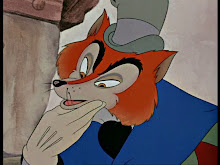
Writer/director Sam Raimi is back in the horror fold after a nearly ten-year absence from the genre that started his career. Fans of Raimi's Evil Dead trilogy rose up in excitement upon hearing the news that the director would return to horror with this film, but then quickly became trepidacious when the movie was given a PG-13 rating. Surely a horror film can not possibly be enjoyable without buckets of blood and gratuitous female nudity-- as we all realize, PG-13 films such as Poltergeist, Psycho, Gremlins, Tremors, Jaws, and virtually every horror film made before the 1960's were all mediocre at best (unlike quality R-rated horror like the upcoming Sorority Row). Worried fans can calm their nerves though, Drag Me to Hell returns Raimi back to his roots as a sylish, inventive and unique filmmaker.
Christine Brown (Alison Lohman) has a great job at a bank, a boyfriend that loves her (Justin Long), and even has a kitten (Ben Affleck). Everything changes, of course, when the elderly and phlemy gypsy Mrs. Ganush, (Lorna Raver) comes into the bank to stop a foreclosure on her home. With the chance to earn the Assistant Manager position she's vying for, Christine denies the old woman a third extension on her mortgage. Clearly Christine hasn't watched or read Thinner, because soon afterward, she learns that she has been cursed, and after three days of torment, the assailing spirit will drag her down into hell itself. If the plot seems a little thin and contrived, that's likely because it is, but it is within convention that Raimi succeeds in being unconventional.
Scenes of torment begin with the usual elements of specific lighting, camera angles and sounds-- Raimi knows that we know the usual rhythms for these things, and he deliberately plays with them, holding a scary note for an extra long time, or waiting an extra beat before cutting loose. And sure enough, Raimi goes all out when a confrontation takes place, but it's impossible to discuss in detail without spoiling some of the best moments of the film. I will say though, I feel the use of stationary and livestock in this film is second to none. But, again, Raimi is careful to make sure the gross-out stuff produces smiles and not vomit. While his trademark dark sense of humor oozes throughout the production, even at its most hopeful, you can’t shake the main character’s sense of impending doom, driving her further into desperation. What is also interesting about the character of Christine is that she isn’t weak-willed or an easy victim; she fights back every chance she gets and you can’t help but want to see her succeed.
The film isn't entirely without fault though-- the CG used in the film, while minimal, isn't always particularly good, especially when practical effects are used to greater affect in other scenes. The ending is also entirely predictable after a key scene towards the end of the film, but it’s so well done and fantastic to watch that you don’t care.
Drag Me to Hell is Sam Raimi's love letter to Evil Dead fans, and proof positive that years in the corporate machine making those Arachnid-Boy movies (or whatever they're called), never separated him from his roots as a unique filmmaker with a sick, twisted, but very funny mind.
Welcome back Mr. Raimi, the horror genre has missed you greatly.
4.5/5

 Who is real, and who is the Thing--that question infuses John Carpenter's film,
Who is real, and who is the Thing--that question infuses John Carpenter's film, 
